Airports of the Future
Jewel Changi Airport | Singapore | Safdie Architects
Green Machine
Designers reinvent the airport experience with deft engineering, unusual geometry, and a vast indoor garden.
By Joann Gonchar, FAIA
Say the word “airport” and even the most intrepid road warriors are likely to think of the headaches associated with air travel, such as lost luggage, delayed flights, intrusive security screenings, and long lines at international entry points. Travelers are probably not envisioning a verdant landscape with cascading water features or meandering walking trails. But that is what people encounter inside Jewel at Singapore’s Changi Airport. The $1.2 billion structure, designed by Cambridge, Massachusetts-based Safdie Architects, weaves retail space, food outlets, and passenger conveniences together with a flourishing green space of palm and bamboo trees, canyons, and a 130-foot-tall waterfall—all within an immense, climate-controlled toroidal glass enclosure.
The 1.7 million-square-foot Jewel, which sits on the site of a former surface parking lot and connects to three of the airport’s four terminals, is the outcome of a competition that Safdie entered with developer CapitaLand. It is part of a set of long-range projects that aim to increase the airport’s capacity from 65 million to 135 million passengers by 2030, including a third runway and a terminal designed by Heatherwick Studio, KPF, and Architects 61. The aspiration for Jewel was not only to entice more people to travel through Changi, but also build upon its curious popularity among Singaporeans as a destination in its own right—a place readily accessible to the rest of the island via mass transit, where the nontraveling public can shop, eat, and spend leisure time. Toward those goals, the 2014 request for proposals called for a shopping mall, airport services that included early check-in facilities and baggage storage, plus an unspecified “attraction.”
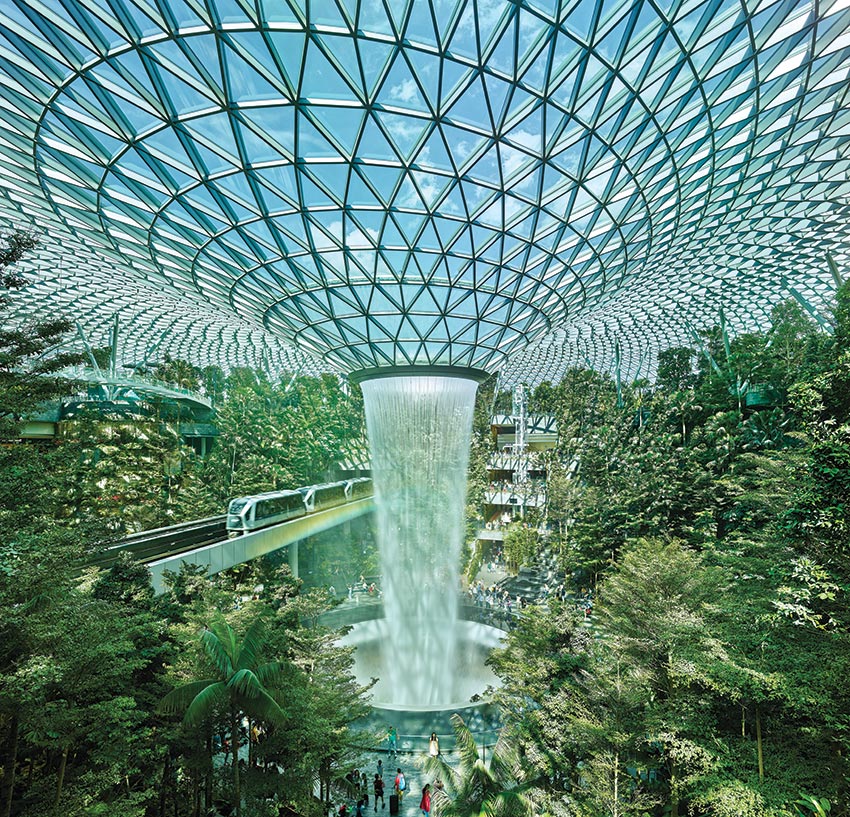
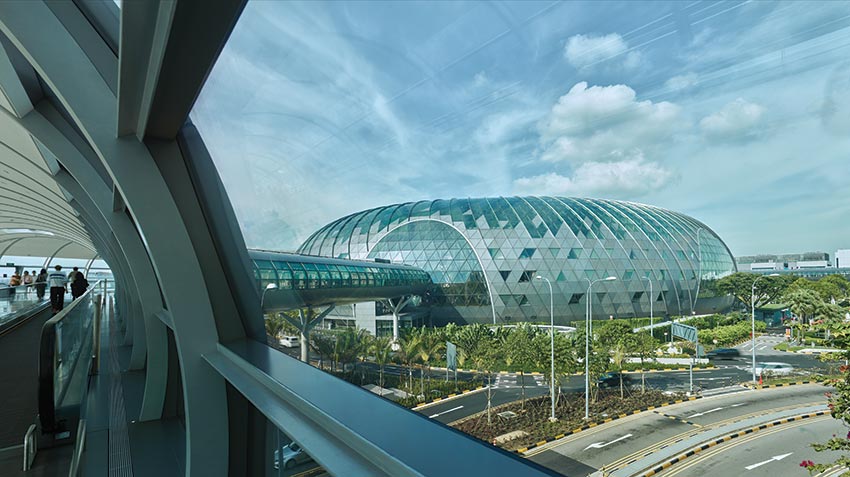
Photography by Tim Hursley
CRYSTAL PALACE The centerpiece of Jewel’s toroidal glass-and-steel dome is a funnel-shaped oculus from which a “rain vortex” flows at up to 10,000 gallons per minute (opposite). Tubular pedestrian bridges (above) connect the building to two of Changi’s terminals.
To fulfill this open-ended part of the brief, Moshe Safdie, the architecture firm’s founder, proposed a “mythical garden” as the focal point around which Jewel’s other programmatic elements could be organized and as a fitting gateway to the famously lush city-state. Dubbed the “forest valley,” the resulting green space takes the form of an 80-foot-tall stepped elliptical void that is topped with a “canopy park” with follies such as a topiary walk, a mirrored maze, and a glass-bottomed bridge. Encircling the valley on four levels above grade and two below (with 2,500 subterranean parking spaces below that), are a shopping mall, a movie theater, a hotel, and other traveler conveniences. These amenities are kept separate from the green space, but the designers sliced slot-like “canyons” through the valley bowl, providing visual connections between the two distinct environments. Conscious of the disorienting potential of buildings with round footprints, the architects have also arranged the cuts to provide views to the outside, including one aligned with the air traffic control tower.
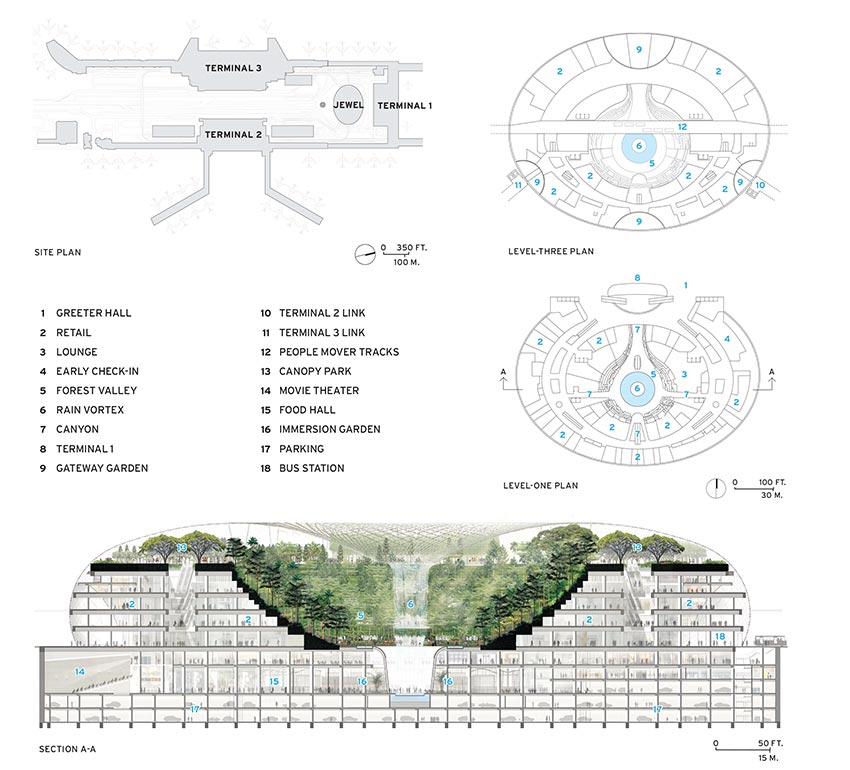
The valley and the spaces around it have a mostly conventional concrete-and-steel structure. But the toroid, a glass-and-steel grid shell 675 feet across at its widest point, is highly sophisticated, and largely self-supporting, except for 14 treelike columns. The shell consists of hollow-section steel beams, 4 inches wide and of varying depths, connected by precision steel nodes. The grid shell launches from a ring beam that encircles Jewel at its fifth level and marks a transition in the cladding, with mostly aluminum panels below it and glass above. The roof system spans to the funnel-shaped oculus, from which the veil of water called the “rain vortex” falls.
The vortex, designed by the water feature specialists WET, drops up to 10,000 gallons per minute down seven stories and is Jewel’s most popular selfie spot. However, it is not at the physical center. The waterfall has been positioned slightly to the south to avoid dousing a pre-existing tram that transports passengers between terminals and now traverses Jewel’s valley every few minutes. That placement of the vortex resulted in a subtly irregular doughnut shape for the toroid and meant that no two of the shell’s more than 9,000 double-glazed, triangular panels are alike. This added complexity, of course, but digital design and fabrication methods helped manage the variation, says Craig Schwitter, a partner in the New York office of BuroHappold Engineering, Jewel’s structural and facade consultant. Jaron Lubin, a Safdie Architects principal, points to the parametric model that provides a “recipe” for determining the number, shape, and size of glazing units. It helped designers and the glazing subcontractor “prune” or manipulate the radial geometry, so that none of the panels is too large at the perimeter or too small near the center, he explains.
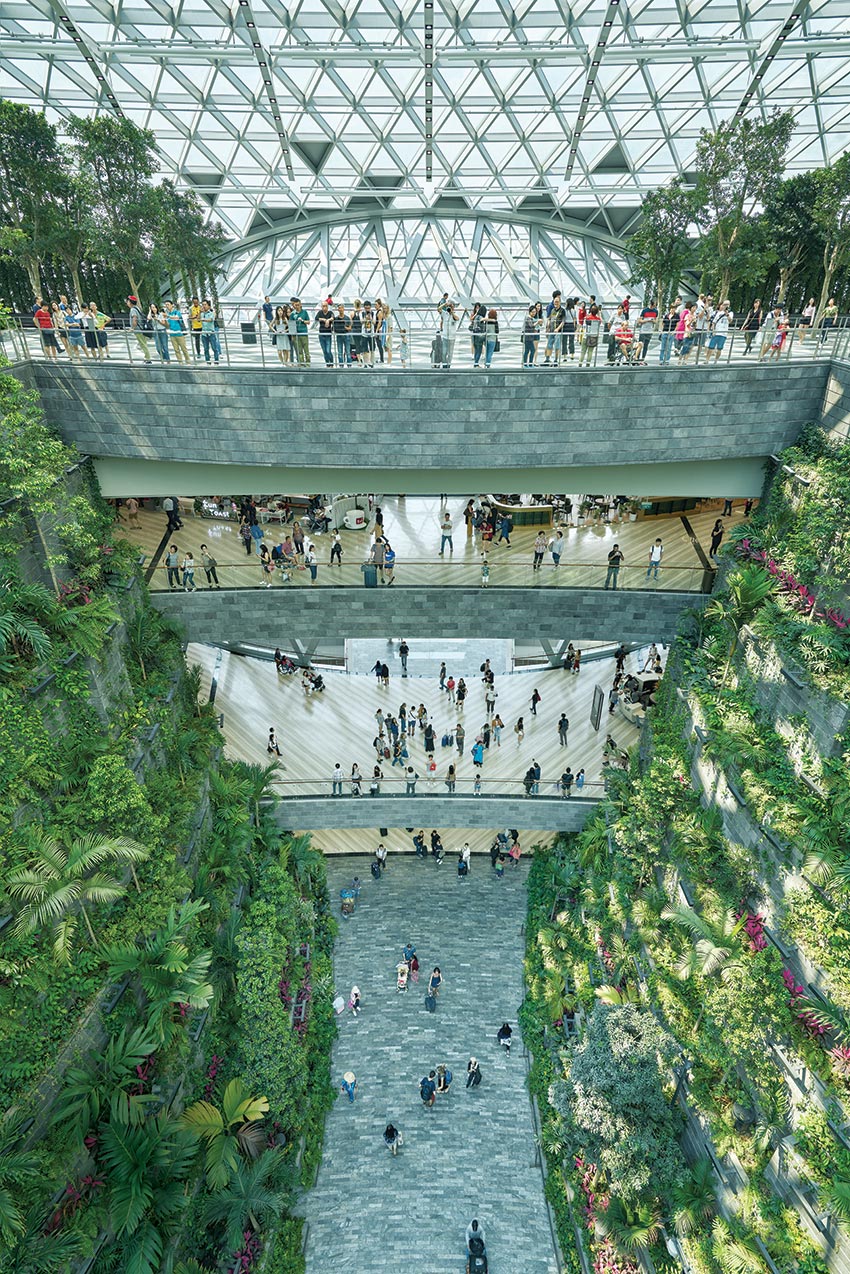
Photography by Tim Hursley
VIEW SHED Slot-like slices through Jewel’s “valley” allow views to neighboring spaces and the exterior, helping prevent visitors from becoming disoriented by the circular form.
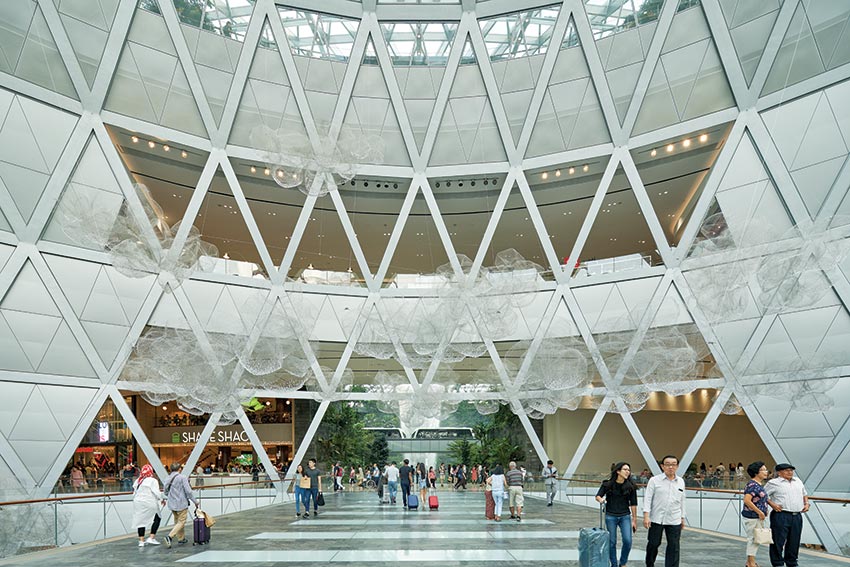
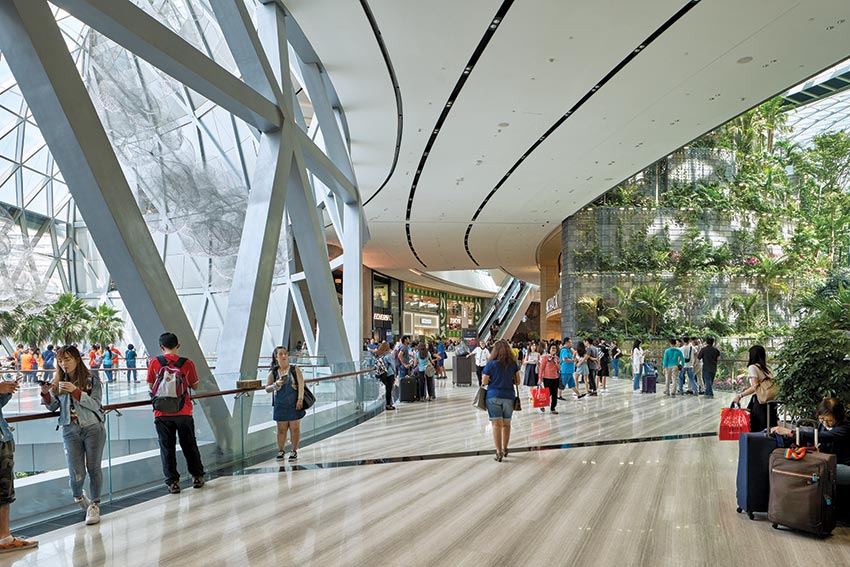
Photography by Tim Hursley
RETAIL WRAP A shopping mall (right) encircles the valley on four levels above grade and two below. As visitors approach Jewel from Changi’s Terminal 1, to which it is directly connected, the vendors and the central green space beyond come into view (above).
To maintain comfortable conditions for both people and plants under the enormous glass bubble, and ensure the building would not be an energy hog, the team enlisted the help of Atelier Ten. The environmental consultant developed the central green space’s climate-control strategy, studying such aspects as heat gain on the envelope, which could be mitigated by coatings and the density of frit patterns on the glazing; and the impact of the rain vortex, so that it would create a pleasant cooling effect rather than big wind gusts. “We wanted some air movement, but not too much,” explains Meredith Davey, an Atelier Ten director in London. “Jewel is all about balance,” he says. Thus, the mechanical system relies on displacement ventilation, supplying fresh air at a low velocity from floor-level vents (many cleverly concealed in architectural elements, including seating), so that only the occupied portions of the vast volume are conditioned. The system is one of many features that helped Jewel earn Gold Plus, the second-highest certification level under Singapore’s GreenMark building-rating program.
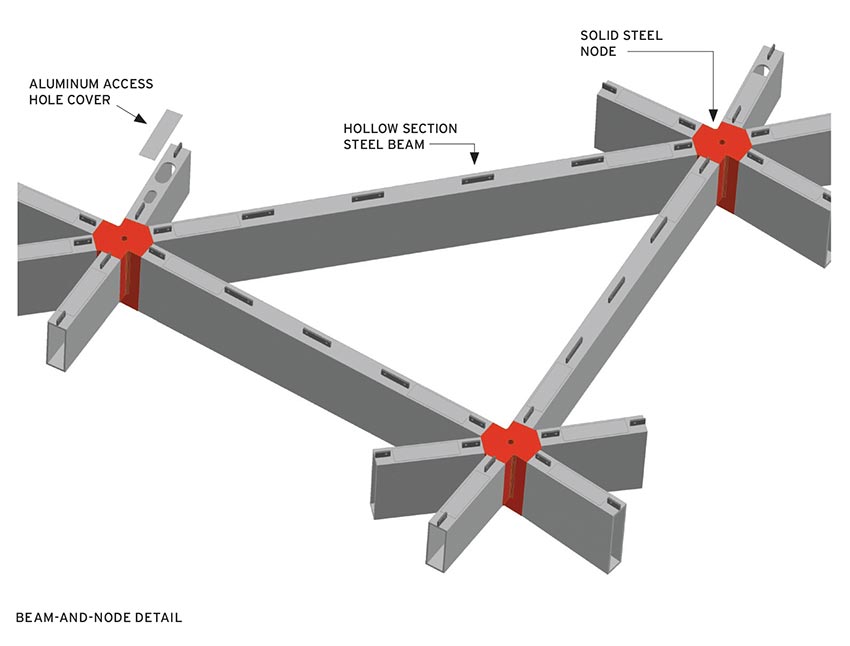
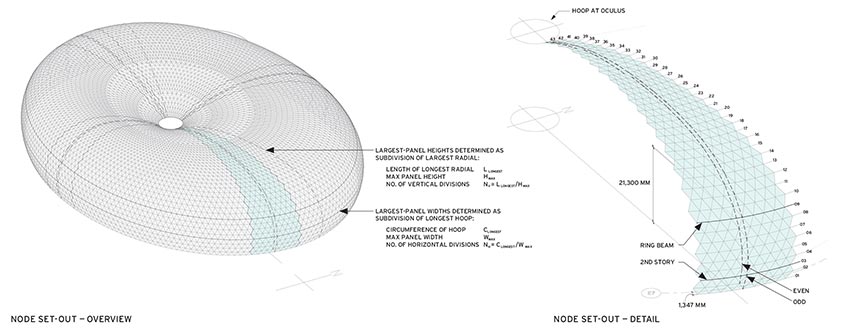
Baking Instructions
The doughnut-shaped grid shell consists of hollow-section steel beams connected by precision steel nodes (top). Designers compare the parametric model of the domed enclosure (above) to a “recipe” for determining the size, shape, and number of its triangular glazing units.
Since the client deemed that 75 degrees Fahrenheit and 60 percent humidity were the optimum conditions for people—considerably cooler and dryer than Singapore’s climate—Berkeley, California–based PWP Landscape Architecture selected Jewel’s trees, shrubs, and other flora from subtropical zones throughout the world. Many of the plants were tested within a “coolhouse” that matched design conditions as closely as possible and, once procured, acclimated in nurseries in Singapore for up to two years before being placed within Jewel’s irrigated trenches, according to Adam Greenspan, a PWP design partner.
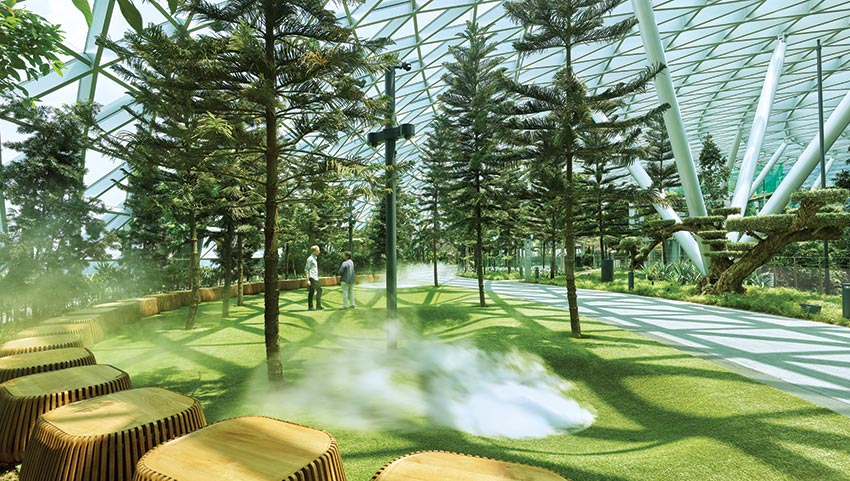
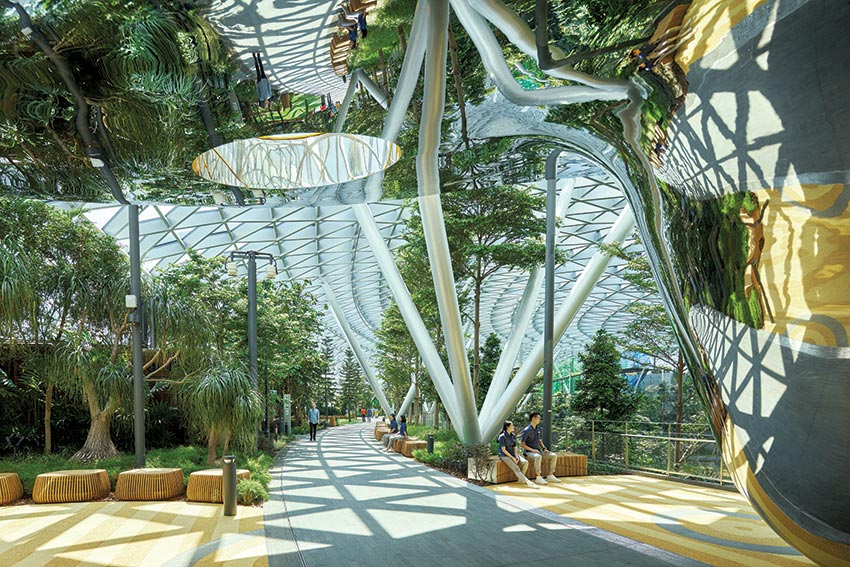
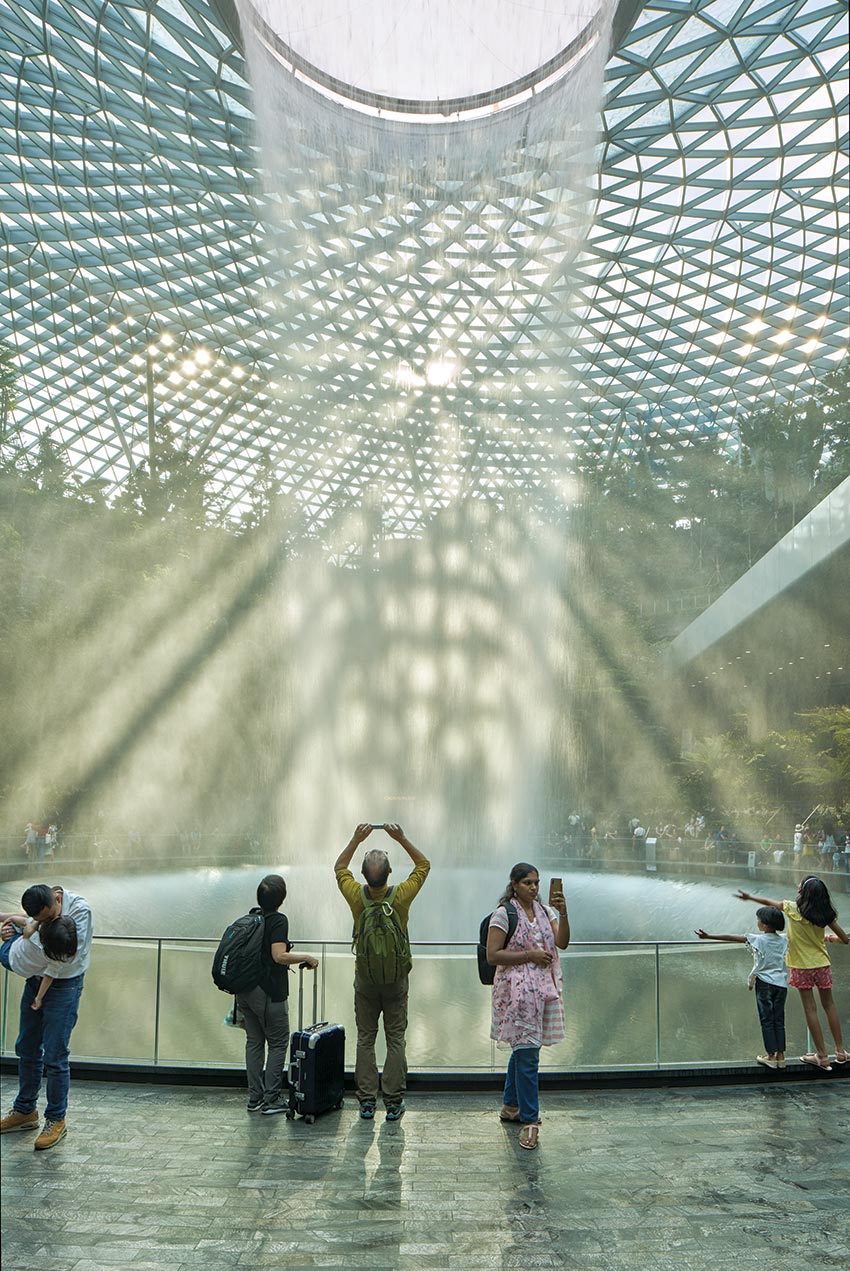
Photography by Tim Hursley
SELFIE MAGNET In addition to the Instagrammable rain vortex (opposite), Jewel contains several other folly-like attractions, including a set of foggy bowls (top) and a series of sculptural, mirrored slides (above).
The landscape approach has proved so successful, says Lubin, that there are spots within Jewel where you are completely shrouded in greenery. Visitors won’t think they are in an actual forest, he admits. But they can forget that they are at the airport—at least momentarily.
Credits
Architect: Safdie Architects — Moshe Safdie, lead designer; Jaron Lubin, Charu Kokate, Greg Reaves, principals; David Foxe, Seunghyun Kim, Benjy Lee, Dan Lee, Peter Morgan, Reihaneh Ramezany, Laura Rushfeldt, Isaac Safdie, Damon Sidel, Temple Simpson, Lee Hua Tan, Andrew Tulen, project teamArchitect of Record: XRSP Architects Planners & Engineers
Consultants: BuroHappold Engineering (roof structure and facades); Mott MacDonald Singapore (m/e/p); Ignesis Consultants (fire); Arup Singapore (acoustics); Atelier Ten (environmental); WET Design (water feature); PWP Landscape Architecture, ICN International Singapore (landscape); Benoy (retail); Lighting Planners Associates (lighting)
General Contractor: Woh Hup
Owner: Changi Airport Group
Size: 1.7 million square feet
Cost: $1.2 billion
Completion date: April 2019 (Phase I)
Sources
Facade: Mero Asia Pacific, Choon Hin Stainless Steel, Yongnam Holdings, Alucobond, Vitro Architectural Glass, CSG Holding, Colt LouvresDoors and Hardware: Tacam Steel, Flamelite, Dormakaba, Won-Door, CLF Shutters, Briton, Elmes
Conveyance: Schindler Group









